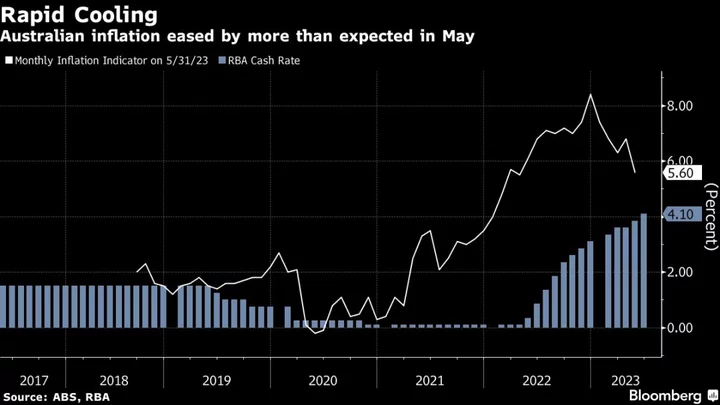Australia’s inflation eased more than expected in May, bolstering the case for the Reserve Bank to pause its 14-month tightening cycle at next week’s policy meeting and sending the currency lower.
The consumer price indicator rose 5.6% in May from a year earlier, down from 6.8% in April and slower than the forecast 6.1% gain, Australian Bureau of Statistics data showed Wednesday. After excluding volatile items, the annual trimmed-mean gauge eased to 6.1% from 6.7% in April.
Traders pared bets for an interest-rate hike at Tuesday’s meeting, and the currency dropped to 66.26 US cents at 11:46 am in Sydney, taking its loss to 1%, with the three-year government bond yield also lower. Stocks extended gains to 1.3%.
“This month’s annual increase of 5.6% is the smallest increase since April last year,” said Michelle Marquardt, ABS head of prices statistics. When excluding volatile items, “the decline in inflation is more modest,” she said.
Governor Philip Lowe has said the RBA is now in data-dependent mode when it comes to rate decisions after 4 percentage points of hikes since May 2022, with inflation’s trajectory key to the outlook. An unexpected acceleration in monthly consumer prices prompted the central bank to deliver a surprise rate hike earlier this month.
Wednesday’s data follows reports that consumers are winding back spending, particularly as mortgage holders are forced to outlay a rising proportion of their income on loan repayments. Retail figures due on Thursday are expected to show the spending all-but stagnated last month, while business confidence is also weakening.
On the other side, Australia’s labor market persists in defying the odds as hiring remains strong and the jobless rate unexpectedly fell.
Still, the balance of data suggests sufficient evidence for the RBA to stand pat.
Economists at Citigroup Inc. said that investors should focus on the components of the monthly inflation reading rather than the headline number as not all expenditure is measured — unlike the quarterly report. In May, only 64% of services and 76% of goods prices were updated.
“For the RBA’s July decision, the key focus will be on housing inflation,” Citi’s Josh Williamson said in a research note ahead of the release. “Ongoing price increases in other services categories, other parts of recreation and culture and a lack of deflation in goods items suggests hawkish RBA risks despite the weaker headline result.”
Today’s monthly CPI report showed:
- The most significant contributors to the annual increase in May were housing, up 8.4%, food and non-alcoholic beverages, 7.9% higher, and furniture, household equipment and services rose 6%
- Partly offsetting the rise was an 8% fall in automotive fuel
- Rent prices went up again to 6.3% in May from 6.1% a month earlier “as the rental market remains tight,” the bureau said
--With assistance from Garfield Reynolds, Matthew Burgess and Georgina McKay.
(Adds chart, further details from release.)

